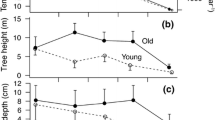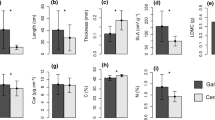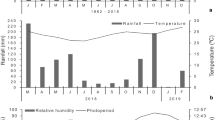Abstract
Metrosideros polymorpha, a dominant tree species in Hawaiian ecosystems, occupies a wide range of habitats. Complementary field and common-garden studies of M. polymorpha populations were conducted across an altitudinal gradient at two different substrate ages to ascertain if the large phenotypic variation of this species is determined by genetic differences or by phenotypic modifications resulting from environmental conditions. Several characteristics, including ecophysiological behavior and anatomical features, were largely induced by the environment. However, other characteristics, particularly leaf morphology, appeared to be mainly determined by genetic background. Common garden plants exhibited higher average rates of net assimilation (5.8 μmol CO2 m−2 s−1) and higher average stomatal conductance (0.18 mol H2O m−2 s−1) than their field counterparts (3.0 μmol CO2 m−2 s−1, and 0.13 mol H2O m−2 s−1 respectively). Foliar δ13C of most common-garden plants was similar among sites of origin with an average value of −26.9‰. In contrast, mean values of foliar δ13C in field plants increased substantially from −29.5‰ at low elevation to −24.8‰ at high elevation. Leaf mass per unit area increased significantly as a function of elevation in both field and common garden plants; however, the range of values was much narrower in common garden plants (211–308 g m−2 for common garden versus 107–407 g m−2 for field plants). Nitrogen content measured on a leaf area basis in common garden plants ranged from 1.4 g m−2 to 2.4 g m−2 and from 0.8 g m−2 to 2.5 g m−2 in field plants. Photosynthetic nitrogen use efficiency (PNUE) decreased 50% with increasing elevation in field plants and only 20% in plants from young substrates in the common garden. This was a result of higher rates of net CO2 assimilation in the common garden plants. Leaf tissue and cell layer thickness, and degree of leaf pubescence increased significantly with elevation in field plants, whereas in common garden plants, variation with elevation of origin was much narrower, or was entirely absent. Morphological characteristics such as leaf size, petiole length, and internode length decreased with increasing elevation in the field and were retained when grown in the common garden, suggesting a potential genetic basis for these traits. The combination of environmentally induced variability in physiological and anatomical characteristics and genetically determined variation in morphological traits allows Hawaiian M. polymorpha to attain and dominate an extremely wide ecological distribution not observed in other tree species.
Similar content being viewed by others
Author information
Authors and Affiliations
Additional information
Received: 12 March 1997 / Accepted: 27 August 1997
Rights and permissions
About this article
Cite this article
Cordell, S., Goldstein, G., Mueller-Dombois, D. et al. Physiological and morphological variation in Metrosideros polymorpha, a dominant Hawaiian tree species, along an altitudinal gradient: the role of phenotypic plasticity. Oecologia 113, 188–196 (1998). https://doi.org/10.1007/s004420050367
Issue Date:
DOI: https://doi.org/10.1007/s004420050367




